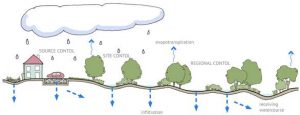SuDS stands for Sustainable Urban Drainage Systems and apparently when searching SuDS trying to find out what they are is one of the most common questions typed into Google, therefore what better way to start my new blog than to provide you with a quick overview.
What do you think of when you think of drainage?
When you think of drainage the images that probably come to mind are pipes buried in the ground, road gullies (probably blocked) and manhole covers. Historically we have believed that water needs to be transported away from our developments as quickly as possible and adopt an approach of it being out of sight, out of mind.
But what if I told you there was another way? What if your drainage could become an asset that could help promote biodiversity, create better spaces and improve water quality? Surly this is something that is in the realms of fantasy?
Well no, SuDS are just that.
So what happens when it rains?
When rainfall falls on an undeveloped site, some of it is lost to groundwater recharge, some to infiltration and some to evapotranspiration, meaning that only a small percentage actually gets into our rivers and streams. As our world has developed we have created vast amounts of impermeable areas through buildings, roads and hardstanding. This has led to the whole process being sped up, with more and more water entering our sewers and rivers which has resulted in an increased risk of flooding.

Source: https://www.susdrain.org/delivering-suds/using-suds/suds-principles/management-train.html
How can SuDS help?
As such SuDS were developed to mimic the natural profile by slowing the flow through attenuation and manging the rainfall close to where it falls. They can also provide additional benefits such as:
- Improving water quality by removing some of the nasties in surface water runoff such as hydrocarbons and silts.
- Providing amenity benefits by helping to create spaces where people want to live and work.
- Creating new areas which promote biodiversity and create new habitats for our wildlife and insect populations.
It is a little bit like having the opportunity to buy one and get three free.
SuDS can be used on nearly all drainage schemes and we will be looking at the various components available in a little more detail over future entries but if you want to know more and can’t wait why not get in touch for a quick chat so we can tell you more about how SuDS could benefit your projects.